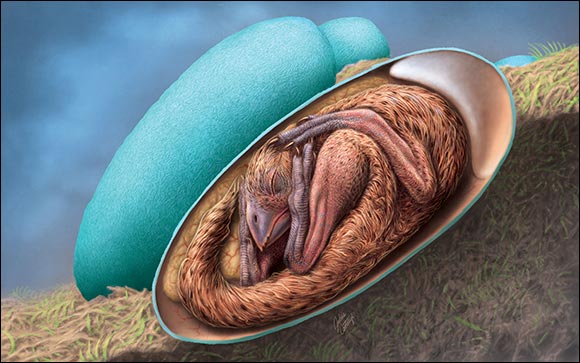
Exquisitely Preserved Embryo found inside Fossilised Dinosaur Egg
A 72 to 66-million-year-old embryo found inside a fossilised dinosaur egg sheds new light on the link between the behaviour of modern birds and dinosaurs, according to a new study.
The embryo, dubbed ‘Baby Yingliang’, was discovered in the Late Cretaceous rocks of Ganzhou, southern China and belongs to a toothless theropod dinosaur, or oviraptorosaur. Among the most complete dinosaur embryos ever found, the fossil suggests that these dinosaurs developed bird-like postures close to hatching.
Scientists found the posture of ‘Baby Yingliang’ unique among known dinosaur embryos — its head lies below the body, with the feet on either side and the back curled along the blunt end of the egg. Previously unrecognised in dinosaurs, this posture is similar to that of modern bird embryos.
In modern birds, such postures are related to ‘tucking’ — a behaviour controlled by the central nervous system and critical for hatching success. After studying egg and embryo, researchers believe that such pre-hatching behaviour, previously considered unique to birds, may have originated among non-avian theropods.
Led by scientists from the University of Birmingham and China University of Geosciences (Beijing), the research team from institutions in China, UK and Canada today published its findings in iScience.
The embryo is articulated in its life position without much disruption from fossilisation. Estimated to be 27 cm long from head to tail, the creature lies inside a 17-cm-long elongatoolithid egg. The specimen is housed in Yingliang Stone Nature History Museum.
Fion Waisum Ma, joint first author and PhD researcher at the University of Birmingham, said: “Dinosaur embryos are some of the rarest fossils and most of them are incomplete with the bones dislocated. We are very excited about the discovery of 'Baby Yingliang' - it is preserved in a great condition and helps us answer a lot of questions about dinosaur growth and reproduction with it.
“It is interesting to see this dinosaur embryo and a chicken embryo pose in a similar way inside the egg, which possibly indicates similar prehatching behaviours.”
‘Baby Yingliang’ was identified as an oviraptorosaur based on its deep, toothless skull. Oviraptorosaurs are a group of feathered theropod dinosaurs, closely related to modern-day birds, known from the Cretaceous of Asia and North America. Their variable beak shapes and body sizes are likely to have allowed them to adopt a wide range of diets, including herbivory, omnivory and carnivory.
Birds are known to develop a series of tucking postures, in which they bend their body and bring their head under their wing, soon before hatching. Embryos that fail to attain such postures have a higher chance of death due to unsuccessful hatching.
By comparing ‘Baby Yingliang’ with the embryos of other theropods, long-necked sauropod dinosaurs and birds, the team proposed that tucking behaviour, which was considered unique to birds, first evolved in theropod dinosaurs many tens or hundreds of millions of years ago. Additional discoveries of embryo fossils would be invaluable to further test this hypothesis.
Professor Lida Xing from China University of Geosciences (Beijing), joint first author of the study, said: “This dinosaur embryo was acquired by the director of Yingliang Group, Mr Liang Liu, as suspected egg fossils around the 2000. During the construction of Yingliang Stone Nature History Museum in 2010s, museum staff sorted through the storage and discovered the specimens.
“These specimens were identified as dinosaur egg fossils. Fossil preparation was conducted and eventually unveiled the embryo hidden inside the egg. This is how ‘Baby Yingliang’ was brought to light.”
Professor Steve Brusatte from the University of Edinburgh, part of the research team, said: “This dinosaur embryo inside its egg is one of the most beautiful fossils I have ever seen. This little prenatal dinosaur looks just like a baby bird curled in its egg, which is yet more evidence that many features characteristic of today’s birds first evolved in their dinosaur ancestors.”
Home >> Home, Furniture and Interiors Section
Hamdan bin Rashid Al Maktoum Centre for Giftedness and Innovation Team Achieves ...
TCL Electronics introduces the latest QD-Mini LED TV and smart home appliances i ...
GEMS Modern Academy honoured with NAFIS Award for outstanding support of Emirati ...
Our museums are inspiring global communication platforms and vital institutions ...
Emirates Receives Certified Autism Center™ Designation Plaques for all Check In ...
The Treasures of the Library Exhibition at Mohammed Bin Rashid Library… A Museum ...
Arabian Automobiles Presents ‘The Unusual Suspects'
The Science Behind Chery's Pure Air: Enhancing Passenger Well-Being
Mubadala Investment Company Reports 2023 Financial Results
Turkish Airlines Becomes the Main Sponsor of the Taş Tepeler Project
Noatum Launches Maritime Services in Türkiye
A Blissful Summer Package for an Ultimate Luxury Stay at Sofitel Dubai Downtown
Mint joins hands with S2M to transform financial services landscape
Styched Sets Sights on UAE's Booming Fashion Market
AUS named among top 125 in THE Young University Rankings 2024
Emirates returns to Nigeria from 1 October
The Environment Agency – Abu Dhabi Starts the First Reintroduction Phase of Dama ...
Emirates invites UAE's cabin crew candidates to exclusive events
Family Development Foundation launches “Kindness and Mercy” campaign to raise aw ...
Ford Middle East achieves highest first-quarter sales since 2016
